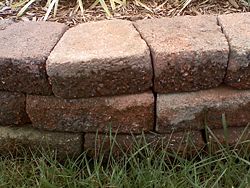Stone
 From Citizendium
From Citizendium Building structures from stone is the foundation of masonry. Stone has been used in structures for thousands of years. Although modern materials have become a dominant choice in the building and construction industry, stone still has a place for it's qualities of durability, beauty, and representation as an iconic material.
In geology, the materials from which building stones are obtained are generally termed rocks. Rocks can come in three naturally different forms:
- Igneous rocks comes from the cooling of magma, either at the earth's surface following a volcanic eruption or within earth's crust. Igneous rocks are often hard and non-porous. The classical igneous building stone is granite, not to be confused with the engineered stone with the same name.
- Sedimentary rocks are often relatively soft compared to other types of rocks. Most come from sediments produced by erosion, which settled into layers, were compacted and lithified over time. An example of this kind of rocks is sandstone. Limestones instead formed by the precipitation of carbonates from seawater.
- Metamorphic rocks are also often hard and non-porous but come from rocks that ware changed by pressure or heat at the contact with bodies of magma or deep in the crust. Marble is a distinct example of metamorphic rock, derived from the metamorphism of a limestone; in marbles, you can often see veins and folded dark horizons that formed during the plastic deformation of the parent limestone.
These different types of stone lend themselves to different applications. For example, because sedimentary rock is softer than igneous or metamorphic stone, it would not be the best choice for a retaining wall, or in applications that involve running water.
Much of the stone used in construction comes from quarries, that exist as a part of mining for some other mineral, or are a source of a particular stone to begin with. The stone pulled from these chasms in the earth's crust is very "raw", and may be sent to a masonry to be refined or shaped, especially in the case with marble.
Engineered stone[edit]
Most stone used in construction is naturally occurring. Engineered stone is technically made of natural stone types, but is manufactured to include other materials like resin and concrete in order to afford additional strength. Almost all engineered stone is 90 or more percent natural quartz, the hardest of non-precious minerals, but there are some types such as granite that are as low as 50 percent quartz and contain resins, other minerals and impurities. This granite is not the same as naturally occurring granite, which is found in "El Capitan" or the "Half Dome" at Yosemite, and the "Monte Bianco(Mont Blanch)" in the Alps. The engineered type of granite can be referred to as "commercial-grade", because it is produced.
Applications[edit]
Stone has many advantages for use in construction. When structures are built correctly (providing a foundation for the structure; drainage if necessary; mortar between stone, etc) stone structures can have long lifetimes. Some roads, particularly those in historical districts, were paved with different types of stone or brick and are still intact. Also many historical buildings, such as the Washington Monument have proven resilient against natural weathering and damage--although maintenance has been necessary throughout the monument's lifetime due to the effects of acidity in rain on marble.
↧ Download as ZWI file | Last modified: 01/11/2024 13:03:17 | 23 views
☰ Source: https://citizendium.org/wiki/Stone | License: CC BY-SA 3.0
 ZWI signed:
ZWI signed:

 KSF
KSF